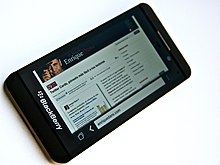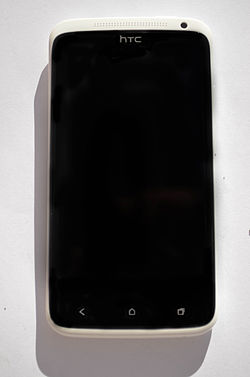The
iPhone 4S is a
touchscreen-based
smartphone developed by
Apple Inc. It is the fifth generation of the
iPhone,
[5] succeeding the
iPhone 4, and was announced on October 4, 2011. It became available for pre-order on October 7, 2011 in seven initial countries (United States, Canada, Australia, United Kingdom, France, Germany and Japan) with the first delivery date set for October 14, 2011, and available on that same day for direct in-store sales in those countries. It was released in 22 more countries, including Ireland, Mexico, and Singapore, on October 28.
[6]
The phone retains the exterior design of its predecessor, but hosts improved hardware specifications and
software updates.
[7] It added a voice recognition system known as
Siri from which the "4S" designator came,
[8] and a cloud storage service named
iCloud. Some of the device's functions may be voice-controlled through Siri. The phone is available for 100 cell service carriers in 70 countries, including eight carriers in the United States.
[9][10] For US customers, unlocked (contract-free) sales started on November 11, 2011.
[11][12] The
Associated Press said that AT&T described early
iPhone 4S demand as "extraordinary".
[13] Reception to the
iPhone 4S was generally favorable. Reviewers noted Siri, the new camera, and processing speeds as significant advantages over the prior model.
[14][15][16] Four million units of the
iPhone 4S were sold in the first three days of release.


Comparison between the GSM iPhone 4 hardware (top) and
iPhone 4S hardware (bottom). Notice the repositioned stainless steel antennae which form the perimeter around the phone.
The
iPhone 4S has a
stainless steel, dual cellular antenna design. Apple redesigned the antenna in the
iPhone 4S after some original iPhone 4 users reported cellular signal attenuation problems as a result of holding the phone in certain positions. The improved cellular radio in the phone can switch between two antennas, depending on which is sending/receiving the best signal. These two antennas are incorporated into the distinctive stainless steel band that wraps around the sides of the
iPhone 4S.
[45] The bands on the iPhone 4S are divided into two antennas:
cellular and
Global Positioning System GPS, with
Bluetooth and
Wi-Fi reliant on an internal antenna.
[19][50]
The iPhone 4 and 4S were designed by
Jonathan Ive. The '4' generation iPhones differ from earlier Apple designs; the bulges of the back panel as well as the band between the front and back are gone and have been replaced with flattened surfaces. The redesign reflects the
utilitarianism and uniformity of existing Apple products, such as the
iPad and the
iMac. The overall dimensions of the
iPhone 4S are lower than that of the 3GS.
[51]
It is 4.53 inches (115 mm) high, 2.31 inches (59 mm) wide, and 0.37 inches (9.4 mm) deep, compared to the iPhone 3GS, which is 4.55 inches (116 mm) high, 2.44 inches (62 mm) wide, and 0.48 inches (12 mm) deep; making the iPhone 4 and 4S 21.5% thinner than the
3GS. The internal components are situated between two panels of
aluminosilicate glass, described by Apple as being "chemically strengthened to be 20 times stiffer and 30 times harder than plastic," theoretically allowing it to be more scratch resistant and durable than the prior models.
[52][53]








_270x405.jpg)




